SNVS252H September 2003 – November 2018 LM5007
PRODUCTION DATA.
- 1 Features
- 2 Applications
- 3 Description
- 4 Revision History
- 5 Pin Configuration and Functions
- 6 Specifications
- 7 Detailed Description
-
8 Application and Implementation
- 8.1 Application Information
- 8.2
Typical Application
- 8.2.1 Design Requirements
- 8.2.2
Detailed Design Procedure
- 8.2.2.1 Custom Design With WEBENCH® Tools
- 8.2.2.2 Custom Design With Excel Quickstart Tool
- 8.2.2.3 Feedback Resistors, RFB1 and RFB2
- 8.2.2.4 Switching Frequency Selection, RON
- 8.2.2.5 Buck Inductor, L1
- 8.2.2.6 Output Capacitor, COUT
- 8.2.2.7 Type I Ripple Circuit, RC
- 8.2.2.8 Input Capacitor, CIN
- 8.2.2.9 Current Limit, RCL
- 8.2.3 Application Curves
- 9 Power Supply Recommendations
- 10Layout
- 11Device and Documentation Support
- 12Mechanical, Packaging, and Orderable Information
Package Options
Mechanical Data (Package|Pins)
Thermal pad, mechanical data (Package|Pins)
Orderable Information
7.3.9 Ripple Configuration
The LM5007 uses an adaptive constant on-time (COT) control in which the conduction time of the buck MOSFET is terminated by an on-timer and the off-time is terminated by the feedback voltage (VFB) falling below the reference voltage (VREF). Therefore, for stable operation, the feedback voltage must decrease monotonically and in phase with the inductor current during the off-time interval. Furthermore, this change in feedback voltage (VFB) during the off-time must be larger than any noise component present at the feedback node.
Table 1 shows three different methods for generating appropriate voltage ripple at the feedback node. Type 1 and Type 2 ripple circuits couple the ripple at the output of the converter to the feedback node (FB). The output voltage ripple has two components:
- Capacitive ripple caused by the inductor current ripple charging/discharging the output capacitor.
- Resistive ripple caused by the inductor current ripple flowing through the ESR of the output capacitor.
The capacitive ripple is not in phase with the inductor current. As a result, the capacitive ripple does not decrease monotonically during the off-time. The resistive ripple is in phase with the inductor current and decreases monotonically during the off-time. The resistive ripple must exceed the capacitive ripple at the output node (VOUT) for stable operation. If this condition is not satisfied, unstable switching behavior is observed in COT converters with multiple on-time bursts in close succession followed by a long off-time.
Type 3 ripple method uses Rr and Cr and the switch node (SW) voltage to generate a triangular ramp. This triangular ramp is ac coupled using Cac to the feedback node (FB). Since this circuit does not use the output voltage ripple, it is ideally suited for applications where low output voltage ripple is required. See AN-1481 Controlling Output Ripple and Achieving ESR Independence in Constant On-Time (COT) Regulator Designs (SNVA166) for more details for each ripple generation method.
Table 1. Ripple Configuration
| TYPE 1
LOWEST COST CONFIGURATION |
TYPE 2
REDUCED RIPPLE CONFIGURATION |
TYPE 3
MINIMUM RIPPLE CONFIGURATION |
|---|---|---|
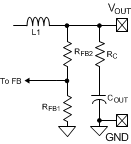 |
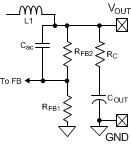 |
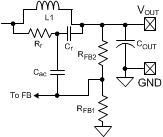 |
|
Equation 6.
 |
Equation 7.
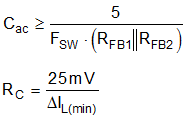 |
Equation 8.
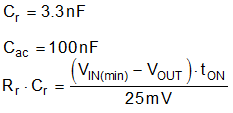
|